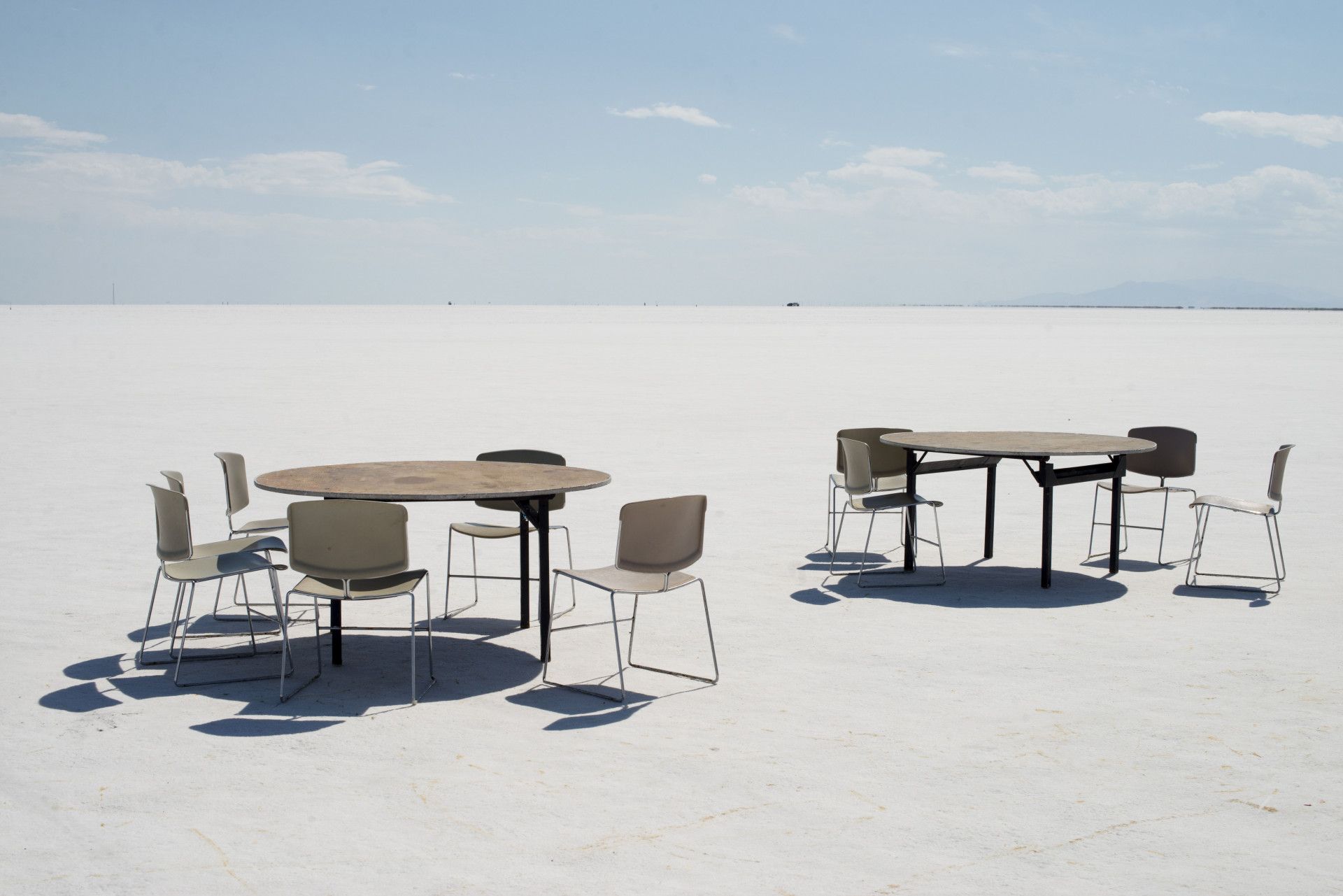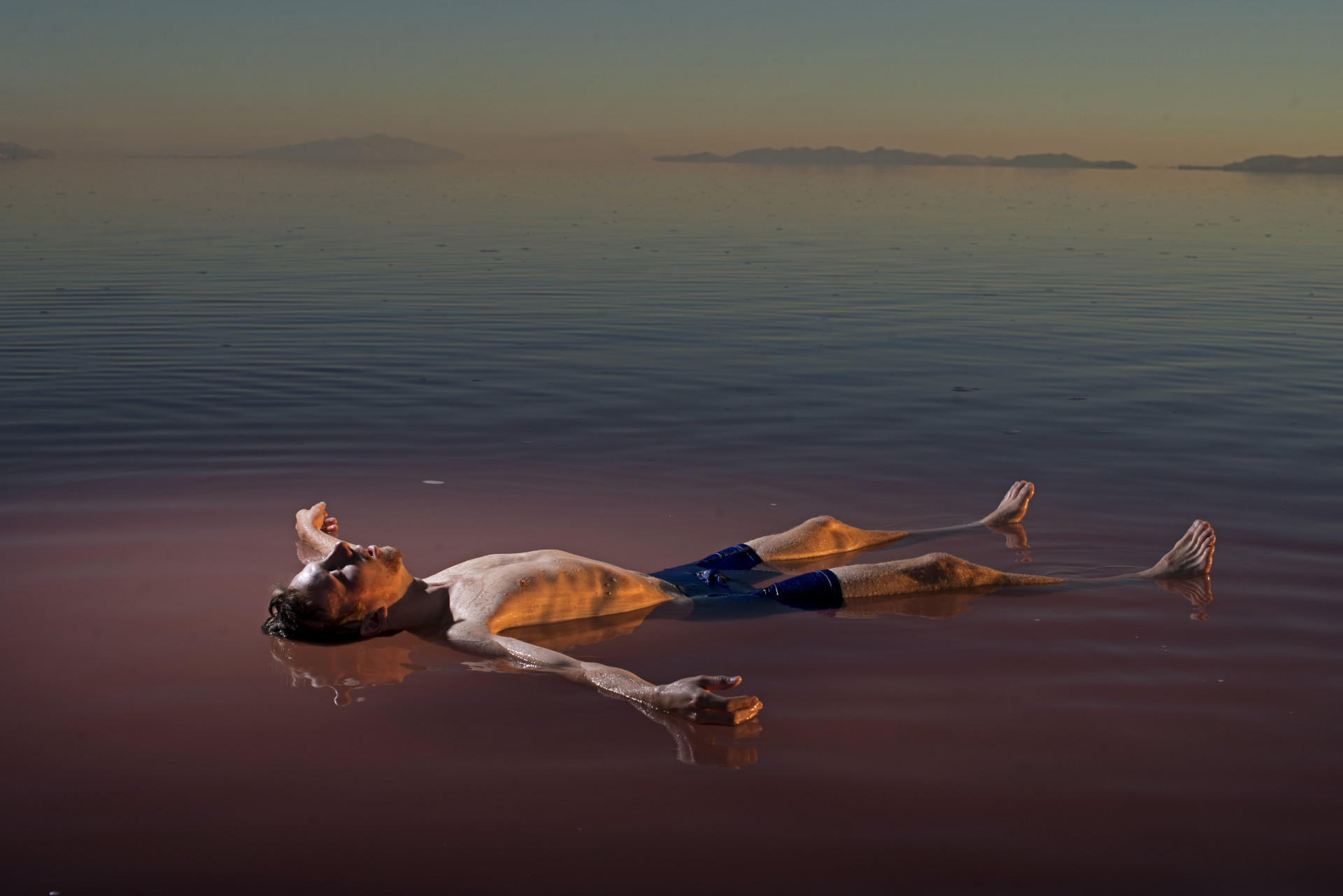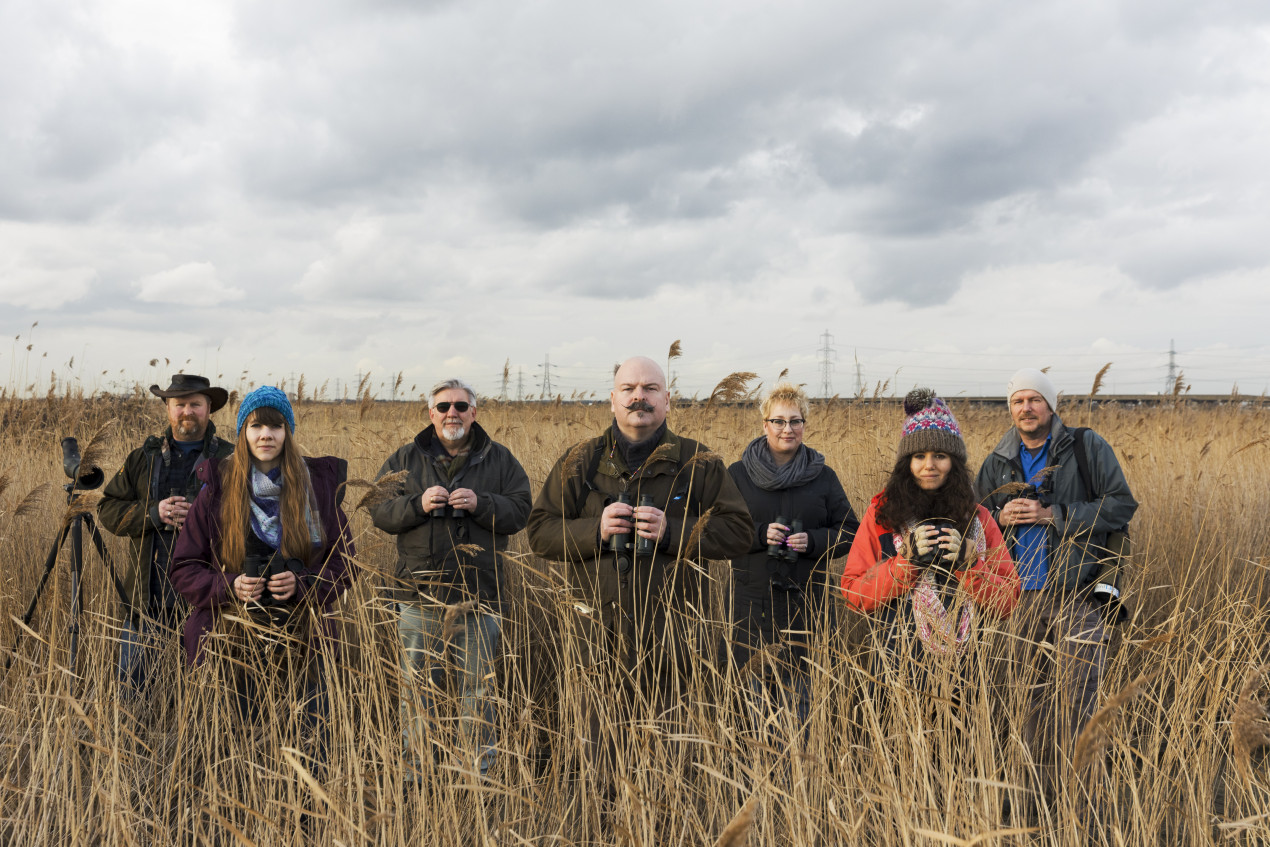The Bonneville Salt Flats, a densely packed salt pan that is a remnant of the Pleistocene Lake Bonneville and is the largest of many salt flats located west of the Great Salt Lake. It is public land managed by the Bureau of Land Management and is known for land speed records at the "Bonneville Speedway". This day was part of the annual "World of Speed" event. USA. Wendover, UT.
© Carolyn Drake | Magnum Photos
The Bonneville Salt Flats, a densely packed salt pan that is a remnant of the Pleistocene Lake Bonneville and is the largest of many salt flats located west of the Great Salt Lake. It is public land managed by the Bureau of Land Management and is known for land speed records at the "Bonneville Speedway". This day was part of the annual "World of Speed" event. USA. Wendover, UT.
© Carolyn Drake | Magnum Photos
Migrating birds depicted on a mural on a highway underpass. The Great Salt Lake wetlands are a critical link in the flyway between North and South America, with 3 to 6 million birds, representing 250 species visiting and nesting annually. USA. Salt Lake City, UT
© Carolyn Drake | Magnum Photos
Participant at annual World Speed event at Bonneville Salt Flats, a densely packed salt pan that is a remnant of the Pleistocene Lake Bonneville and is the largest of many salt flats located west of the Great Salt Lake. It is public land managed by the Bureau of Land Management and is known for land speed records at the "Bonneville Speedway". USA. Wendover, UT.
© Carolyn Drake | Magnum Photos
Bear River Migratory Bird Refuge is a 74,000-acre National Wildlife Refuge in Utah, established in 1928. It encompasses the Bear River and its delta where it flows into the northern part of the Great Salt Lake. Water entering the area is controlled by a system of canals. Some units are dried out to allow water to enter other units and attract birds. It is managed by the U.S. Fish and Wildlife Service. USA. Brigham City, UT.
© Carolyn Drake | Magnum Photos
Howard Browers. Bear River Migratory Bird Refuge is a 74,000-acre National Wildlife Refuge in Utah, established in 1928. It encompasses the Bear River and its delta where it flows into the northern part of the Great Salt Lake. Water entering the area is controlled by a system of canals. Some units are dried out to allow water to enter other units and attract birds. It is managed by the U.S. Fish and Wildlife Service. USA. Brigham City, UT.
© Carolyn Drake | Magnum Photos
Bird watching organized by the Audubon Society on Antelope Island Sunday morning. USA. Syracuse, UT.
© Carolyn Drake | Magnum Photos
Bird watching organized by the Audubon Society on Antelope Island Sunday morning. USA Syracuse, UT.
© Carolyn Drake | Magnum Photos
Antelope Island campground. Antelope Island with an area of 42 square miles is the largest of 10 islands located within the Great Salt Lake but it is actually a peninsula. Bison were introduced in 1893. The island is a state park. Aroha Zollinger and Fraser Gould, at dusk, from New Zealand, traveling 3 months out of van in USA. Syracuse, UT
© Carolyn Drake | Magnum Photos
R Jefre Hicks, a great salt lake activist and hunter, takes me out on his airboat in Ogden Bay. The bay is covered in phragmites, a weed that takes over the wetlands and spreads rapidly, reducing habitat available for birds and other wildlife. R spends a lot of time cutting down the phragmites with his chain saw. USA. Ogden, UT.
© Carolyn Drake | Magnum Photos
Northeast shore of the Great Salt Lake near the spiral jetty. In 1959, a 30-foot stone railroad causeway replaced the battered wood trestle. As a result, lake circulation reduced drastically. Great Salt Lake now has two distinct sections, the north arm and the south arm. The water in the north arm has a high salt concentration of approximately 26–28% due to little freshwater input. Only two types of known bacteria can currently live in the saturated North Arm waters: the halophiles Halobacterium and Halococcus. A purplish pigment in these halophiles is responsible for the unique reddish color of GSL's northern section. USA. Great Salt Lake, UT
© Carolyn Drake | Magnum Photos
Antelope Island campground. Antelope Island with an area of 42 square miles is the largest of 10 islands located within the Great Salt Lake but it is actually a peninsula. Bison were introduced in 1893. The island is a state park. USA. Syracuse, UT
© Carolyn Drake | Magnum Photos
Northeast shore of the Great Salt Lake near the spiral jetty. In 1959, a 30-foot stone railroad causeway replaced the battered wood trestle. As a result, lake circulation reduced drastically. Great Salt Lake now has two distinct sections, the north arm and the south arm. The water in the north arm has a high salt concentration of approximately 26–28% due to little freshwater input. Pelicans migrate from their nesting ground across the lake to find food every season and many cannot make the long trek and get stuck in the salt on the shore of the north arm.USA. Great Salt Lake, UT
© Carolyn Drake | Magnum Photos
R Jefre Hicks, a great salt lake activist and hunter, takes me out on his airboat in Ogden Bay. He stops at a spot where an airboat got stuck in the mud last winter USA. Ogden, UT
© Carolyn Drake | Magnum Photos
R Jefre Hicks, a great salt lake activist and hunter, takes me out on his airboat in Ogden Bay. He stops at a spot where an airboat got stuck in the mud last winter USA. Ogden, UT.
© Carolyn Drake | Magnum Photos
R Jefre Hicks, a great salt lake activist and hunter, takes me out on his airboat in Farmington Bay. The bay is covered in phragmites, a weed that takes over the wetlands and spreads rapidly, reducing habitat available for birds and other wildlife. Many carp in this spot died due to low water levels and low oxygen levels. USA. Farmington, UT.
© Carolyn Drake | Magnum Photos
R Jefre Hicks, a great salt lake activist and hunter, takes me out on his airboat in Ogden Bay. The bay is covered in phragmites, a weed that takes over the wetlands and spreads rapidly, reducing habitat available for birds and other wildlife. R spends a lot of time cutting down the phragmites with his chain saw. USA. Farmington, UT.
© Carolyn Drake | Magnum Photos
Youth hunt early in the morning at Farmington Bay. This is a duck hunting day before the regular hunting season starts just for youth. Cody Freeman and his son Coogan. USA. Farmington, UT.
© Carolyn Drake | Magnum Photos
Youth hunt on Willard Bay organized by Chuck Harsin. This is a duck hunting day before the regular hunting season starts just for youth (accompanied by guardians or parents).USA. Willard, UT.
© Carolyn Drake | Magnum Photos
After killing invasive phragmites weeds with roundup on several units of the Bear River Migratory Bird Refuge, the phragmites is destroyed through a planned burn. The refuge is a 74,000-acre National Wildlife Refuge in Utah, established in 1928. It encompasses the Bear River and its delta where it flows into the northern part of the Great Salt Lake. Water entering the area is controlled by a system of canals. It is managed by the U.S. Fish and Wildlife Service. USA. Brigham City, UT.
© Carolyn Drake | Magnum Photos
Youth hunt on Willard Bay organized by Chuck Harsin. This is a duck hunting day before the regular hunting season starts just for youth (accompanied by guardians or parents).USA. Willard, UT.
© Carolyn Drake | Magnum Photos
This is the area where new dams are proposed on the Bear River that would further deplete the water supply of the Great Salt lake in the future. These are agricultural lands and growing cities owned and occupied mainly by members of LDS, a rapidly growing population. USA. Logan Area, UT
© Carolyn Drake | Magnum Photos
Bear River Migratory Bird Refuge is a 74,000-acre National Wildlife Refuge in Utah, established in 1928. It encompasses the Bear River and its delta where it flows into the northern part of the Great Salt Lake. Water entering the area is controlled by a system of canals. Some units are dried out to allow water to enter other units and attract birds. It is managed by the U.S. Fish and Wildlife Service. USA. Brigham City, UT.
© Carolyn Drake | Magnum Photos
R Jefre Hicks, a great salt lake activist and hunter, takes me out on his airboat in Farmington Bay. The bay is covered in phragmites, a weed that takes over the wetlands and spreads rapidly, reducing habitat available for birds and other wildlife. Many carp in this spot died due to low water levels and low oxygen levels.USA. Farmington, UT
© Carolyn Drake | Magnum Photos
Russell James, a photography student from Utah State makes tin types of the Spiral Jetty on the north arm of the great salt lake. USA. Great Salt Lake, UT
© Carolyn Drake | Magnum Photos
For her PHD research, Taylor Hannah along with John Neil and other biologists, takes a boat out from Antelope Island marina to trap two eared grebes and attach satellite devices to their bodies to track their movements during their down months on the great salt lake. USA. Salt Lake City, UT
© Carolyn Drake | Magnum Photos
For her PHD research, Taylor Hannah along with John Neil and other biologists, takes a boat out from Antelope Island marina to trap two eared grebes and attach satellite devices to their bodies to track their movements during their down months on the great salt lake. USA. Salt Lake City, UT
© Carolyn Drake | Magnum Photos
For her PHD research, Taylor Hannah along with John Neil and other biologists, takes a boat out from Antelope Island marina to trap two eared grebes and attach satellite devices to their bodies to track their movements during their down months on the great salt lake.USA. Salt Lake City, UT.
© Carolyn Drake | Magnum Photos
Russell James, a photography student from Utah State makes tin types of the Spiral Jetty on the north arm of the great salt lake. In 1959, a 30-foot stone railroad causeway replaced the battered wood trestle. As a result, lake circulation reduced drastically. Great Salt Lake now has two distinct sections, the north arm and the south arm. The water in the north arm has a high salt concentration of approximately 26–28% due to little freshwater input. Only two types of known bacteria can currently live in the saturated North Arm waters: the halophiles Halobacterium and Halococcus USA. Great Salt Lake, UT.
© Carolyn Drake | Magnum Photos
Russell James, a photography student from Utah State makes tin types of the Spiral Jetty on the north arm of the great salt lake. In 1959, a 30-foot stone railroad causeway replaced the battered wood trestle. As a result, lake circulation reduced drastically. Great Salt Lake now has two distinct sections, the north arm and the south arm. The water in the north arm has a high salt concentration of approximately 26–28% due to little freshwater input. Only two types of known bacteria can currently live in the saturated North Arm waters: the halophiles Halobacterium and Halococcus USA. Great Salt Lake, UT.
© Carolyn Drake | Magnum Photos
Balancing on salt crystal rock on north shore of the great salt lake near the Spiral Jetty. Jaden Olson and Benjamin Anderson (left). They are students. In 1959, a 30-foot stone railroad causeway replaced the battered wood trestle. As a result, lake circulation reduced drastically. Great Salt Lake now has two distinct sections, the north arm and the south arm. The water in the north arm has a high salt concentration of approximately 26–28% due to little freshwater input. Only two types of known bacteria can currently live in the saturated North Arm waters: the halophiles Halobacterium and Halococcus. A purplish pigment in these halophiles is responsible for the unique reddish color of GSL's northern section. USA. Great Salt Lake, UT
© Carolyn Drake | Magnum Photos
Swimming on north shore of the great salt lake near the Spiral Jetty. Jaden Olson and Benjamin Anderson. They are students. In 1959, a 30-foot stone railroad causeway replaced the battered wood trestle. As a result, lake circulation reduced drastically. Great Salt Lake now has two distinct sections, the north arm and the south arm. The water in the north arm has a high salt concentration of approximately 26–28% due to little freshwater input. Only two types of known bacteria can currently live in the saturated North Arm waters: the halophiles Halobacterium and Halococcus. A purplish pigment in these halophiles is responsible for the unique reddish color of GSL's northern section.USA. Great Salt Lake, UT
© Carolyn Drake | Magnum Photos
Boyscouts go to take a dip on the salty north shore of the great salt lake near the Spiral Jetty, where they will camp out overnight. In 1959, a 30-foot stone railroad causeway replaced the battered wood trestle. As a result, lake circulation reduced drastically. Great Salt Lake now has two distinct sections, the north arm and the south arm. The water in the north arm has a high salt concentration of approximately 26–28% due to little freshwater input. Only two types of known bacteria can currently live in the saturated North Arm waters: the halophiles Halobacterium and Halococcus. A purplish pigment in these halophiles is responsible for the unique reddish color of GSL's northern section. USA. Great Salt Lake, UT
© Carolyn Drake | Magnum Photos
Floating on the salty north shore of the great salt lake near the Spiral Jetty, Jaden Olson (front) and Benjamin Anderson (blue shorts) They like to go on adventures. they are students. In 1959, a 30-foot stone railroad causeway replaced the battered wood trestle. As a result, lake circulation reduced drastically. Great Salt Lake now has two distinct sections, the north arm and the south arm. The water in the north arm has a high salt concentration of approximately 26–28% due to little freshwater input. Only two types of known bacteria can currently live in the saturated North Arm waters: the halophiles Halobacterium and Halococcus. A purplish pigment in these halophiles is responsible for the unique reddish color of GSL's northern section. USA. Great Salt Lake, UT
© Carolyn Drake | Magnum Photos
A group of women came on the night of the full moon for a dip on the salty north shore of the great salt lake near the Spiral Jetty. They will burn sage and cut out pieces of salt crystal. In 1959, a 30-foot stone railroad causeway replaced the battered wood trestle. As a result, lake circulation reduced drastically. Great Salt Lake now has two distinct sections, the north arm and the south arm. The water in the north arm has a high salt concentration of approximately 26–28% due to little freshwater input. Only two types of known bacteria can currently live in the saturated North Arm waters: the halophiles Halobacterium and Halococcus. A purplish pigment in these halophiles is responsible for the unique reddish color of GSL's northern section. USA. Great Salt Lake, UT
© Carolyn Drake | Magnum Photos
Floating on north shore of the great salt lake near the Spiral Jetty. Benjamin Anderson, a student. In 1959, a 30-foot stone railroad causeway replaced the battered wood trestle. As a result, lake circulation reduced drastically. Great Salt Lake now has two distinct sections, the north arm and the south arm. The water in the north arm has a high salt concentration of approximately 26–28% due to little freshwater input. Only two types of known bacteria can currently live in the saturated North Arm waters: the halophiles Halobacterium and Halococcus. A purplish pigment in these halophiles is responsible for the unique reddish color of GSL's northern section. USA. Great Salt Lake, UT
© Carolyn Drake | Magnum Photos
View west over Farmington Bay and Ogden bay toward antelope Island and the south arm of the great salt lake from Francis Peak. Farmington Bay I was told is one of the most affected by drought, with dried areas blowing dust and creating air pollution. USA. Salt Lake City, UT.
© Carolyn Drake | Magnum Photos
A group of women came on the night of the full moon for a dip on the salty north shore of the great salt late near the Spiral Jetty. They will burn sage and cut out pieces of salt crystal. In 1959, a 30-foot stone railroad causeway replaced the battered wood trestle. As a result, lake circulation reduced drastically. Great Salt Lake now has two distinct sections, the north arm and the south arm. The water in the north arm has a high salt concentration of approximately 26–28% due to little freshwater input. Only two types of known bacteria can currently live in the saturated North Arm waters: the halophiles Halobacterium and Halococcus. A purplish pigment in these halophiles is responsible for the unique reddish color of GSL's northern section. USA. Great Salt Lake, UT
© Carolyn Drake | Magnum Photos
Aerial views of the great salt lake via Utah Helicopter. Highway 80 below the south shore of Great salt lake. USA. Salt Lake City/Great Salt Lake, UT.
© Carolyn Drake | Magnum Photos
Aerial views of the great salt lake via Utah Helicopter. channel of water bleeds toward north arm of the lake under the Railroad causeway. above that are evaporation ponds of compass minerals. In 1959, a 30-foot stone railroad causeway replaced the battered wood trestle. As a result, lake circulation reduced drastically. Great Salt Lake now has two distinct sections, the north arm and the south arm. The water in the north arm has a high salt concentration of approximately 26–28% due to little freshwater input. USA. Salt Lake City/Great Salt Lake, UT.
© Carolyn Drake | Magnum Photos
Aerial views of the great salt lake via Utah Helicopter. These salt windrows are located in a Compass Minerals evaporation pond, and are minerals prepared for harvest and transportation to the nearby sulfate of potash production facility. USA. Salt Lake City/Great Salt Lake, UT.
© Carolyn Drake | Magnum Photos
Aerial views of the great salt lake via Utah Helicopter. Salt over brine in evaporation ponds of compass minerals. USA. Salt Lake City/Great Salt Lake, UT.
© Carolyn Drake | Magnum Photos
Aerial views of the great salt lake via Utah Helicopter. waste water solar evaporation ponds at the neighboring Western Zirconium facility. USA. Salt Lake City/Great Salt Lake, UT.
© Carolyn Drake | Magnum Photos
























































































